FOR ADVERTISING
CONTACT:
Prem Dutt: Email
Call Prem: (916) 743-8316
Seema Gupta: Email
Call Prem: (408) 745-9663
|
|
EDITORIAL:
ICC: Landmark Achievement

At a time of great sectarian turbulence around the world, the India Community Center is living, dazzling proof that India’s talk of unity in diversity is more than just talk.
This is no easy task, given the fact that the size of the expatriate Indian community is so large that it is easy to join the seductive linguistic and religious subgroups that abound even here.
Yet the founders and supporters of ICC chose a vision that is refreshingly inclusive. They decided to open a center where all Indians would be able to meet, fraternize and socialize regardless of which state they were from, what language they spoke and what faith they practiced.
It’s a lofty, wonderful concept. What’s even more commendable is that ICC supporters had the gumption, energy, perseverance and commitment to make it happen.
The result is a 40,000 sq. ft. facility that does the community proud.
ICC has proven that the dream of bringing Indian Americans of diverse backgrounds together was not too far fetched. In the past few years, ICC has actually shown that it’s possible.
It gives us particular pleasure that ICC chair Talat Hasan has taken the time to write about ICC and its goals. Hasan, a Silicon Valley entrepreneur and noted philanthropist, herself epitomizes many of the loftier goals of ICC so well that it’s hard to think of a more appropriate person to write about ICC in our cover story.
Irom Sharmila Chanu is not exactly a household name for South Asians, but perhaps she should be. This gentle, thirty-something Manipuri activist has been on a hunger strike since 2000.
Sharmila is demanding the repeal of the controversial Armed Forces Special Powers Act or AFSPA, which gives sweeping powers to the army in the state.
For many years, the Indian Army has been trying to quell insurgency in Manipur with an iron hand, but its success has been limited. Insurgent groups have proliferated and life for the common people has been mired in violence and strife.
Our editorial consultant Sandeep Pandey, himself a human rights activist, visited Sharmila in Imphal, Manipur, where she is being incarcerated in a hospital. Surprisingly gentle and calm, Sharmila also displays an iron resolve to continue her protest against Army violence. Sandeep also visited a number of sites where civilians had been indiscriminately killed by the Indian Army.
He has written a moving essay on his trip to Manipur in this month’s issue.
It is hardly a secret that the United States faces a health care crisis. Among the industrialized nations, the U.S. spends a greater percentage of its GDP and gets less for it; the single largest cause of personal bankruptcy is exorbitant medical bills; a huge chunk of the population is without medical insurance.
What is worse, in many cases, minority Americans are both much more likely to have a serious and damaging health condition and significantly less likely to be treated for it.
There is a direct correlation in this country between race, ethnicity, and health coverage. Uninsured people are less likely to receive needed primary care and far more likely to suffer the dire and negative consequences of untreated diseases.
So what is to be done? Kaiser Permanente CEO George C. Halvorson makes a pretty compelling case in an article this month for universal health care and better primary care.
Do drop us a line with ideas and comments about how we can make Siliconeer better serve you.
|TOP|
COVER STORY:
Pride of the Community: India Community Center
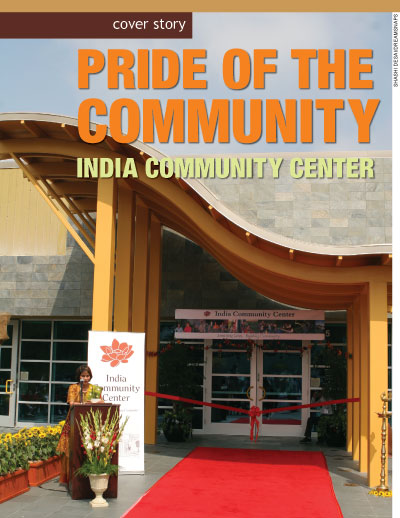 Indians in the Silicon Valley are known for their spectacular success in high technology. Now they may have surpassed themselves when they opened a 40,000 sq. ft. state-of-the-art community center in Milpitas, Calif. Indians in the Silicon Valley are known for their spectacular success in high technology. Now they may have surpassed themselves when they opened a 40,000 sq. ft. state-of-the-art community center in Milpitas, Calif.
With many dozens of programs, the excellence of the facility is matched by its lofty goals—this is the only Indian American facility of its kind which is non-sectarian, non-regional, and welcomes everybody with open arms. Talat Hasan, chair of the India Community Center, shares some thoughts about the center and its goals in an exclusive article written for Siliconeer.
(Left): Executive director Chitra Vivek at the inauguration of India Community Center in Milpitas, Calif.
Is it possible for Indo-Americans to come together as a community, free of religious and regional differences?
When we began to think about the India Community Center nearly five years ago, this was a question looming large in all of our minds. Could the family from Kerala relate to the family from New Delhi? Could the multiple religions of India come together in one facility? What was it that tied India’s rich diversity of languages, food, clothing and customs together?
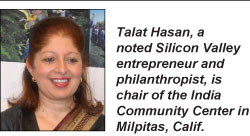 Five years later, surveying the scenes at ICC’s beautiful new home in Milpitas, I see we have greatly surpassed our early expectations of building a non-sectarian, non-communal community! Our seniors — elderly immigrants from all over India — have created a second family at the center, bonding over yoga and dance, lectures and lunch. Our children attend summer camps and have fun learning about India’s rich heritage and national history. Through our language classes, they learn to communicate with the elderly grandparents in their homes. And people of all ages enjoy our new fitness and wellness center — especially our group exercise classes — without thought to the background of the person sweating alongside them. Five years later, surveying the scenes at ICC’s beautiful new home in Milpitas, I see we have greatly surpassed our early expectations of building a non-sectarian, non-communal community! Our seniors — elderly immigrants from all over India — have created a second family at the center, bonding over yoga and dance, lectures and lunch. Our children attend summer camps and have fun learning about India’s rich heritage and national history. Through our language classes, they learn to communicate with the elderly grandparents in their homes. And people of all ages enjoy our new fitness and wellness center — especially our group exercise classes — without thought to the background of the person sweating alongside them.
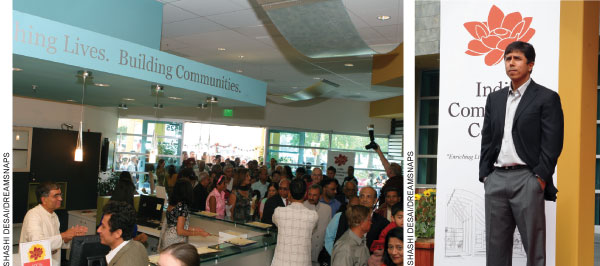
(Above, from left): ICC lobby; and Anil Godhwani, one of the founders of ICC.
The mission of ICC is worth repeating here; it is to promote Indian culture and values by providing social, cultural, recreational and community programs, thereby uniting the Indian community, and raising awareness about Indian culture in the local community.
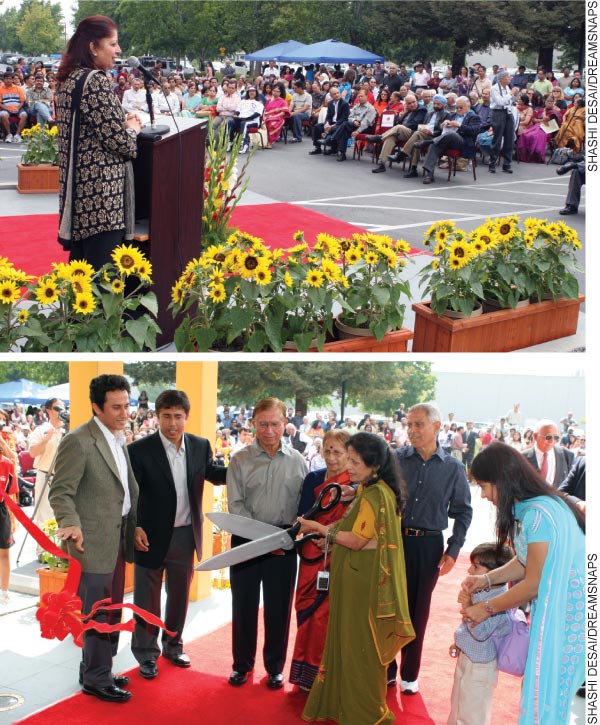
(From top): ICC chair Talat Hasan addressing the audience at the opening of the new ICC facility; and key ICC supporters at the ribbon-cutting ceremony for its 40,000 sq. ft. facility.
What truly amazes me is the amount of support the center has received for this mission of a united Indian community. So many thousands of people have donated time, money, ideas and skills to support ICC’s work!
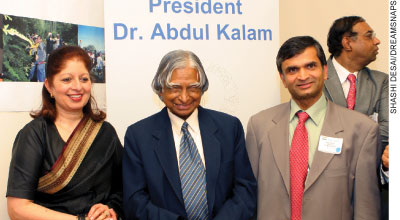 (Right): Former Indian President A.P.J. Abdul Kalam flanked by ICC chair Talat Hasan (l) and ICC supporter Raj Jaswa. (Right): Former Indian President A.P.J. Abdul Kalam flanked by ICC chair Talat Hasan (l) and ICC supporter Raj Jaswa.
ICC’s Community Partners program is key to our mission of building a united community. The center has created a network of more than 65 non-profit organizations, to offer a rich mix of cultural and community services to the Indian community and beyond.
ICC has partnered with The Indus Entrepreneurs to encourage entrepreneurship; the center has partnered with the America India Foundation to encourage philanthropy; and with the newly formed Indo-American Council to encourage political leadership and civic engagement in our community. On October 6, the Indo-American Council will host its inaugural conference in ICC’s new banquet hall, with a wide range of politicians and activists.
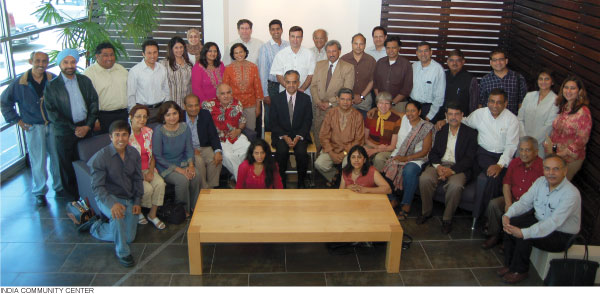
(Above): ICC community advisory council and board.
Our partnerships with other non-profit organizations allow ICC to offer many community services. Every Sunday, volunteer attorneys from the South Asian Bar Association conduct a free legal clinic, specializing in immigration issues and family law. ICC frequently hosts bone marrow drives – critical to finding matches for sick people — through its partnership with the Asian American Donor Program.
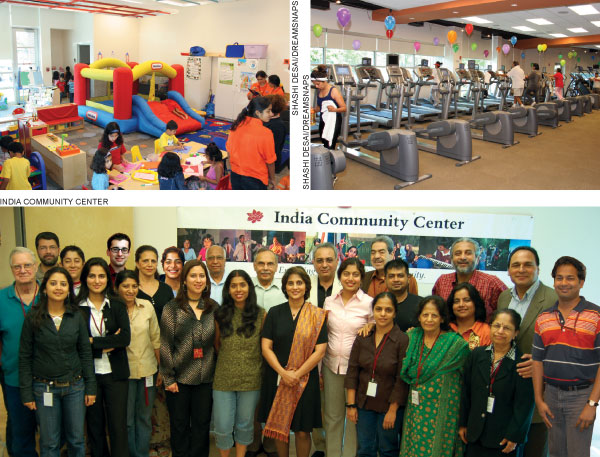
(Clockwise from top): The new ICC fitness center; ICC staff; and kids’ play room at ICC.
I am very proud of a new initiative ICC will launch this fall: our partnership with the American Association of Physicians of Indian Origin in opening the free Medical Clinic at ICC. We have established this clinic with the hopes of serving many of the growing numbers of uninsured people in the Bay Area. ICC has dedicated a 1,000-sq. ft. space to the clinic and volunteer physicians will staff the clinic three times a week. As with all our classes, programs and services, the clinic will be open to anyone who qualifies to use it, regardless of ethnicity.

(Above, Right): The ICC cafeteria; (Below, left): A physical trainer coaches a young girl; and (Below, right): ICC co-founder Anil Godhwani tries his hand at table tennis with a young ICC member.
As the center — and our community — grows, my hope is that we create more of these types of initiatives, to meet the needs of the many underserved people within our midst.
I am very proud of the community we are building here in the Bay Area, and the lives we have enriched. I am confident we can replicate this model of India Community Centers throughout the United States and — perhaps — even in India.
Cover photo: Entrance to ICC (Shashi Desai/DreamSnaps photo)
‘We Still Have Miles to Go,’ Says ICC Executive Director Chitra Vivek
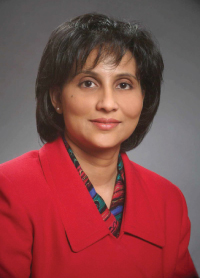 The newly appointed executive director of the India Community Center – has a vision for the organization. Ten years from now, Vivek envisions branches of ICC offering educational, social, cultural, fitness & wellness programs to the communities throughout the United States. “It’s a whole new way of bringing families together” she adds. The newly appointed executive director of the India Community Center – has a vision for the organization. Ten years from now, Vivek envisions branches of ICC offering educational, social, cultural, fitness & wellness programs to the communities throughout the United States. “It’s a whole new way of bringing families together” she adds.
Vivek joined ICC in December, 2006, and was immediately faced with the gargantuan task of moving the center to its new 40,000 square foot, permanent home in Milpitas. ICC opened the doors to its new facility July 1.
“In spite of the daily challenges, I am so proud of what we – our board, our trustees, our staff, our volunteers and our many, many supporters in the community – have accomplished. We still have miles to go, a few donors cannot bear the weight for the community, we need the community to come forward and support the center financially and by becoming members – this is for the community and needs to be supported by the community,” said Vivek
Vivek is a senior business executive with more than 15 years of management experience. She has held several senior management positions at Adaptec with a wide range of responsibilities from corporate strategic planning, business and sales operations to product marketing and account management. Prior to Adaptec, she was with OmniTel. She has received several awards for her excellence and was honoree of the YWCA Tribute to Women and Industry Award in 2004.
“Chitra has a reputation for building great teams,” said ICC chair Talat Hasan. “I’m confident of her ability to bring our organization through this current level of expansion.”
Born and raised in Chennai, India, she currently lives in Fremont with her family. She and her husband live with their parents and two children. Her teenage daughter and tween son have given Vivek another vision for ICC: a safe place where teens can hang out with other teens, and perhaps engage in social service. The new ICC has a fully equipped teen lounge.
|
|TOP|
HUMAN RIGHTS:
Modern-day Meerabai: Irom Sharmila’s Battle
Irom Sharmila Chanu is on hunger strike since 2000, demanding the repeal of the Armed Forces Special Powers Act or AFSPA, which gives sweeping powers to the army in the state. Our India editorial consultant Sandeep Pandey met her recently, and writes about the iconic human rights activist from Manipur.
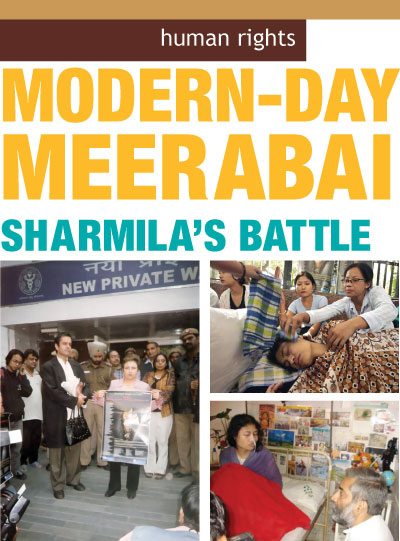 (Left): (Clockwise from left): Iranian rights activist Nobel laureate Shirin Ebadi expressing solidarity for Irom Sharmila; Sharmila being tended by nurses; and Sandeep Pandey with Sharmila in Imphal. (Left): (Clockwise from left): Iranian rights activist Nobel laureate Shirin Ebadi expressing solidarity for Irom Sharmila; Sharmila being tended by nurses; and Sandeep Pandey with Sharmila in Imphal.
I have never felt so humbled before a believer in my life than when I met Irom Sharmila Chanu Sept. 16 at the Jawaharlal Nehru Hospital in Imphal.
On hunger strike since 2000, Irom Sharmila Chanu is being force-fed through a pipe in her nose on the orders of the state administration. The 36-year-old, an iconic figure in Manipur politics, is continuing perhaps the longest such political protest ever recorded.
Sharmila wants the Indian government to scrap the Armed Forces Special Powers Act or AFSPA, which gives sweeping powers to the army in the state.
Manipur, with a population of some 2.3 million, has been administered by the Indian army since 1980 and human rights organizations have been critical of the army’s record.
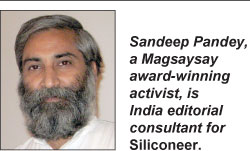 I was in the Manipur capital along with a group of friends who had gone there to organize a five-day solidarity fast in her support. I was expecting to meet a feebler Sharmila than I had met earlier this year at AIIMS in Delhi briefly. But after initially getting carried away during which all of us wept in the hospital ward — converted into a jail for her — she overcame the grief and presented the picture of a brave lady. Her face was radiant. I was surprised that even after seven years of not taking any food or water through her mouth she had a very good mental and physical balance. During the course of our 45-minute interaction, she got up from the bed to bring out a letter written by her to UPA chairperson Sonia Gandhi from the closet in the ward. I was in the Manipur capital along with a group of friends who had gone there to organize a five-day solidarity fast in her support. I was expecting to meet a feebler Sharmila than I had met earlier this year at AIIMS in Delhi briefly. But after initially getting carried away during which all of us wept in the hospital ward — converted into a jail for her — she overcame the grief and presented the picture of a brave lady. Her face was radiant. I was surprised that even after seven years of not taking any food or water through her mouth she had a very good mental and physical balance. During the course of our 45-minute interaction, she got up from the bed to bring out a letter written by her to UPA chairperson Sonia Gandhi from the closet in the ward.
Because of the rubber tube inserted in her nose, she has to lift her head slightly while talking. It must be quite painful for her to have this tube hanging from her nose all the time but now it has become an integral part of her physical body.
Her act can only be described as superhuman. She is the most courageous and patient person I have met in my life. We read about mythological personalities with superhuman qualities but here is living proof of such a person. Sharmila is a living Devi. I’m not a religious person but I drew tremendous inspiration from her and felt very small in front of her.
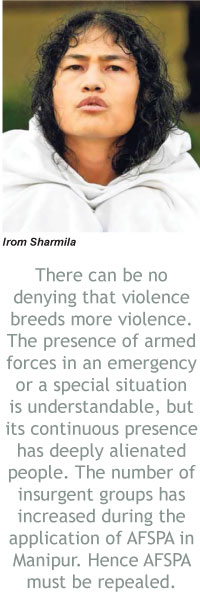 Sharmila said that what she was doing was for all human beings. She said it was God’s will that she should undertake this fast, which can only be compared with a tapasya. She is hopeful that truth will be victorious in the end and the Armed Forces Special Powers Act will be repealed. But she regretted that the Manipur chief minister and governor are not giving her an appointment to meet. She also thought that people are complacent and not fighting as vigorously as they should to get this act repealed. Sharmila said that what she was doing was for all human beings. She said it was God’s will that she should undertake this fast, which can only be compared with a tapasya. She is hopeful that truth will be victorious in the end and the Armed Forces Special Powers Act will be repealed. But she regretted that the Manipur chief minister and governor are not giving her an appointment to meet. She also thought that people are complacent and not fighting as vigorously as they should to get this act repealed.
However, she exhibits no sign of weakness in her resolve. Her brother Irom Singhjit Singh, who got the permission of the chief minister and a whole hierarchy of officials, including jail authorities, for us to meet her, didn’t want to spend any separate time with her, in spite of our insistence, as he probably thought that his presence might weaken her resolve. She shared with us a 1,110 line poem that she has written in Meitei.
Later in that evening we visited some massacre sites — Heirangoiphong, Malom, Tera Bazar and the Regional Institute of Medical Sciences — and lit candles to pay our homage to innocent lives abruptly ended by Indian armed forces. Heirangoiphong is the most heartrending site. Fourteen people were killed here, mostly spectators of a volleyball match, including a CRPF personnel, in 1984. But last year the Army, apparently unable to countenance the memorial built in the memory of these 14 people, tried to demolish it. On Nov. 2, 2000, the Malom massacre of 10 ordinary people, bystanders after an explosion, triggered Irom Sharmila’s fast three days later which continues. On another black day in 1995, at the Regional Institute of Medical Sciences, the Army not killing unarmed civilians,. but also exhibited racial bias by selectively targeting people with mongoloid features.
Today, some doubt that the repeal of AFSPA will bring peace to Manipur. Some ethnic groups in the minority in Manipur, like Kuki and Naga, want AFSPA to remain in place as it provides them security against dominant Meitei insurgent groups. Manipur has about 30 ethnic groups, and there are 25 insurgent groups, some of which are engaged in extortion practices. Some of them have developed a vested interest in continuing the insurgency. They are also engaged in human rights violations just like the armed forces. A Hmar tribal girl was reportedly raped by an insurgent group some time back. These groups frequently disrupt normal economic and developmental activities, causing inconvenience to common citizens. The situation is complicated and there is no easy way out.
However, there can be no denying that violence breeds more violence. The presence of armed forces in an emergency or a special situation is understandable, but its continuous presence has deeply alienated people. The number of insurgent groups has increased during the application of AFSPA in Manipur. Hence AFSPA must be repealed. Meanwhile, like in Kashmir and Nagaland, the central government must begin a process of dialogue with insurgent groups in earnest seeking to accommodate their political demands to the extent possible but respecting their aspirations. It may not be possible for the government to meet some of the demands, especially related to self-determination or autonomy, but a mechanism must be created which will convince the insurgent groups that the possibility of solution according to their wishes exists.
Sharmila’s sacrifice must not go in vain. She has a statue of the legendary Meerabai by the side of her bed in the hospital ward. Sharmila’s deep faith in peaceful methods can only be compared with Meerabai’s immense love for God. The government of India must not dishonor Sharmila’s confidence in democracy and take positive steps towards resolving the current violent crisis in Manipur. All it requires in some political will to act.
|TOP|
NEWS DIARY: September Roundup
 This Dessert is Rich, But Are You? | Waterworld | Son Also Rises | No Smooth Sailing | Goodbye, King This Dessert is Rich, But Are You? | Waterworld | Son Also Rises | No Smooth Sailing | Goodbye, King
This Dessert is Rich, But Are You?
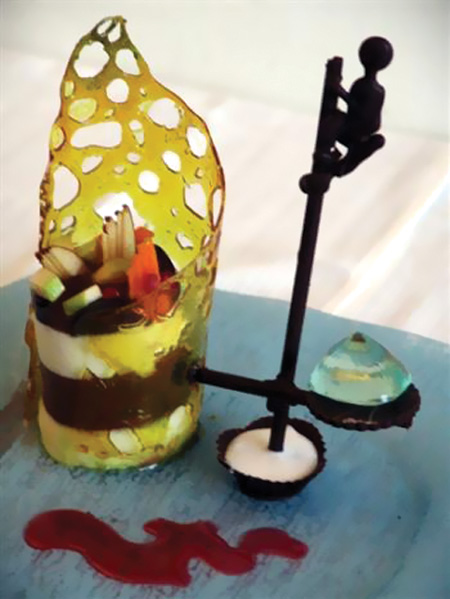 The $14,500 dessert The $14,500 dessert
Not only is this dessert may be a little too rich for you, you’re probably not rich enough for it. A Sri Lankan resort is charging $14,500 for what it calls the world’s most expensive dessert, a fruit infused confection complete with a chocolate sculpture and a gigantic gemstone.
“The Fortress Stilt Fisherman Indulgence” was created to give visitors at The Fortress resort in the coastal city of Galle a one-of-a-kind experience, said the hotel’s public relations manager, Shalini Perera.
The dessert is a gold leaf Italian cassata flavored with Irish cream, served with a mango and pomegranate compote and a champagne sabayon enlighten. The dessert is decorated with a chocolate carving of a fisherman clinging to a stilt, an age old local fishing practice, and an 80 carat aquamarine stone.
The dessert has to be specially ordered, Perera said. Though the hotel has gotten calls about it from as far away as Japan, she said, no one has yet forked over the money to try it.
Good. It means just because there are rich people out there, it doesn’t mean they are dumb enough to indulge their sweet tooth with enough moolah, that spent a little more wisely, could get them a VW Jetta.
|Back to NEWS Diary| |TOP|
Waterworld
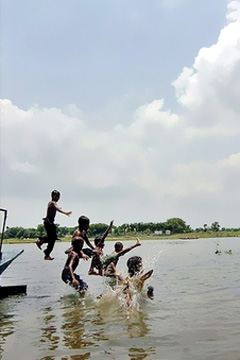 Bangladeshi kids jump into a river. A one-meter rise in sea levels would submerge a third of Bangladesh and displace millions. Bangladeshi kids jump into a river. A one-meter rise in sea levels would submerge a third of Bangladesh and displace millions.
A one-meter rise in sea levels would submerge a third of Bangladesh and displace millions, the head of the country’s military-backed government has warned.
Fakhruddin Ahmed, speaking at a climate change summit at the United Nations in New York, called on richer nations to help poorer countries tackle global warming.
“Today we are confronted with the difficult reality that the phenomenon of climate change is not a myth and that its impacts are no more a conjecture,” the state-run BSS news agency quoted Fakhruddin saying.
“I speak for Bangladesh and many others who are on the threshold of a climate Armageddon, foretold by increasingly violent and unpredictable weather patterns.”
“A one-meter sea level rise will submerge about one-third of the total area of Bangladesh thereby uprooting 25 to 30 million of our people,” Fakhruddin said.
Low-lying Bangladesh has a population of 144 million, 40 percent of whom live on less than a dollar a day.
|Back to NEWS Diary| |TOP|
Son Also Rises
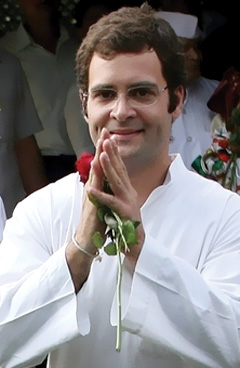 Rahul Gandhi Rahul Gandhi
Rahul Gandhi, 37, was appointed Congress general secretary and inducted into the Congress Working Committee in an indication that the party is preparing for early elections and that the scion of the Nehru-Gandhi dynasty is being groomed for bigger things.
Party workers welcomed his appointment, bursting crackers and distributing sweets.
Congress president Sonia Gandhi also revamped the Manifesto Committee with the appointment of heavyweights including Pranab Mukherjee, Arjun Singh, Veerappa Moily, Digvijay Singh, Mani Shankar Aiyar, Arjun Sengupta and P. Chidambaram.
Signalling a generational shift in the party, Sonia set up a new cell, Group to Look into Future Challenges, in which several members of the “young brigade” have found a place. They include Rahul Gandhi, Jyotiraditya Scindia, Sachin Pilot and Sandeep Dikshit. Union Minister of State for Commerce Jairam Ramesh will be the convener.
Following in his father Rajiv Gandhi’s footsteps, who became general secretary after having been elected to the Lok Sabha in the 1980s, the young Amethi MP is now ready to play a “larger institutional role” in the Congress, a senior leader said. Rahul has been given charge of the Youth Congress and the National Students Union of India.
|Back to NEWS Diary| |TOP|
No Smooth Sailing
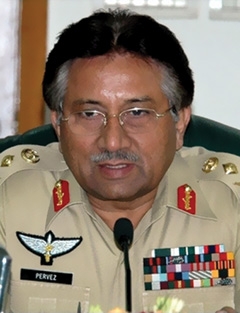 Pervez Musharraf Pervez Musharraf
Although the government’s Election Commission and the Supreme Court have given the green light to Pakistan President Pervez Musharraf's bid for re-election, he is having anything but smooth sailing.
Lawyers and activists angry at his bid to be elected without standing down as army chief have clashed with police, who used batons and tear gas to disperse hundreds of demonstrators in Islamabad and Lahore.
Opposition activists had hoped Gen. Musharraf would be barred from running for president, as he has not yet quit his position as head of the armed forces.
But the Supreme Court dismissed a number of legal challenges, and the Electoral Commission approved his candidacy.
Before the commission's announcement, hundreds of lawyers had taken to the streets in cities including the capital, Islamabad, where they gathered in front of the commission's offices.
Opposition activists are expected to mount further legal challenges to Musharraf's candidacy and campaign for the elections to be postponed.
|Back to NEWS Diary| |TOP|
Goodbye, King
Nepal’s largest political party has abandoned its traditional support for the monarch to back the establishment of a republic in the Himalayan kingdom, party leaders have said.
“The general assembly of the party passed the resolution of going for a federal republic in the upcoming constituent assembly elections,” said Arjun Narsingh K.C., senior leader of the Nepali Congress party.
“We have come to a conclusion that monarchy and democracy cannot go together. The resolution has opened doors for the party to campaign for a republican setup for the November polls,” he said.
The decision is a major blow to King Gyanendra and his two century-old dynasty, already under serious pressure from former Maoist rebels who quit the government and have vowed to disrupt the upcoming polls unless the monarchy is immediately abolished.
Formed in 1946, the Nepali Congress has historically supported a constitutional monarchy.
This changed in 2005 when it removed references to constitutional monarchy from party statutes after King Gyanendra sacked the government and took direct control, a move that prompted bloody street protests and a rise in republican sentiment.
Under the terms of last year’s peace deal that ended a decade of civil war and sidelined the king, the future of the monarchy was supposed to have been decided by a constitutional body due to be democratically elected in November.
|Back to NEWS Diary| |TOP|
|